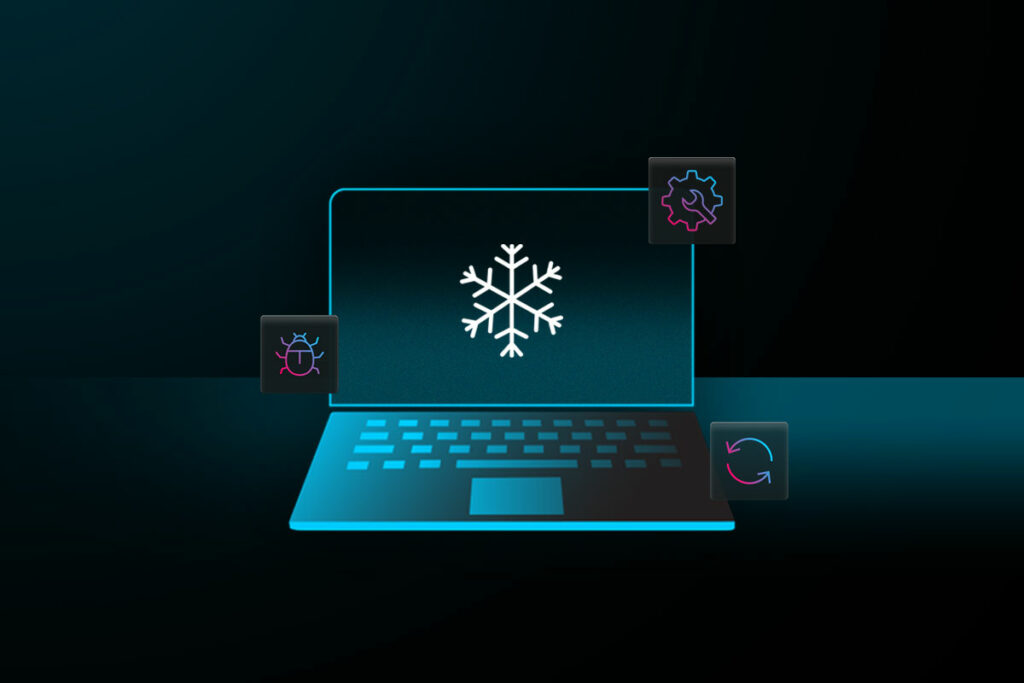Navigating the Digital Chill: Understanding and Troubleshooting Laptop Shutdowns and Freezes

Introduction:
The frustration of experiencing sudden shutdowns or freezes on a laptop can disrupt productivity, compromise data integrity, and leave users searching for answers. In this extensive guide, we’ll delve into the common causes behind laptop shutdowns and freezes, explore troubleshooting techniques, and provide detailed solutions to help users diagnose and resolve these disruptive issues. Whether it’s a software glitch, hardware malfunction, or external factors at play, understanding the root causes is crucial for restoring a laptop to smooth and reliable operation.
Common Causes of Laptop Shutdowns and Freezes:
- Overheating Issues:
- Cause: Laptops generate heat during operation, and if the cooling system is inadequate or fails, the laptop can overheat, triggering shutdowns or freezes.
- Solution: Ensure proper ventilation by cleaning dust from vents and fans. Consider using a cooling pad for improved airflow. If the problem persists, the cooling system or thermal paste may need attention.
- Hardware Malfunctions:
- Cause: Faulty hardware components, such as a failing hard drive, malfunctioning RAM, or a problematic power supply, can lead to unexpected shutdowns or freezes.
- Solution: Run hardware diagnostic tests to identify and address issues with components. Replace or repair faulty hardware as needed.
- Software or Operating System Glitches:
- Cause: Corrupted system files, incompatible drivers, or software conflicts can result in shutdowns or freezes.
- Solution: Boot the laptop into Safe Mode to troubleshoot software-related issues. Update drivers, run antivirus scans, and perform system restores to revert the operating system to a stable state.
- Power Supply Issues:
- Cause: Problems with the laptop’s power supply, such as a failing battery or malfunctioning power adapter, can lead to sudden shutdowns.
- Solution: Test the laptop with an alternate power adapter and battery. Replace or repair the faulty power supply component.
- Operating System Updates:
- Cause: Incomplete or problematic operating system updates can introduce bugs or compatibility issues, leading to shutdowns or freezes.
- Solution: Check for pending updates and ensure they are successfully installed. Roll back recent updates if the problem started after an update.
- Malware or Virus Infections:
- Cause: Malicious software can disrupt normal system operation, leading to unexpected shutdowns or freezes.
- Solution: Run comprehensive antivirus scans to detect and remove malware or viruses. Consider using reputable anti-malware software for a more thorough scan.
- Memory Issues:
- Cause: Insufficient RAM or faulty RAM modules can lead to performance issues, causing the laptop to freeze or shut down unexpectedly.
- Solution: Check system resource usage and upgrade RAM if needed. Test and replace faulty RAM modules.
- Driver Conflicts:
- Cause: Incompatible or outdated device drivers can cause conflicts, resulting in system instability.
- Solution: Update drivers to the latest versions provided by the laptop manufacturer. Uninstall and reinstall problematic drivers.
Step-by-Step Troubleshooting Tips:
- Check for External Factors:
- Ensure the laptop is placed on a flat, stable surface for proper ventilation.
- Disconnect external peripherals and accessories to rule out external factors.
- Monitor Temperature and Ventilation:
- Download temperature monitoring software to check for overheating issues.
- Clean dust from vents and fans to improve airflow.
- Perform Hardware Diagnostics:
- Run built-in diagnostic tools provided by the laptop manufacturer to test hardware components.
- Check for errors in the hard drive, RAM, and other critical components.
- Software Troubleshooting:
- Boot the laptop into Safe Mode to isolate software-related issues.
- Update operating system, drivers, and essential software.
- Roll back recent system changes, such as updates or installations.
- Power Supply Inspection:
- Test the laptop with an alternate power adapter and battery.
- Replace or repair the faulty power supply component if needed.
- Run Antivirus and Anti-Malware Scans:
- Use reputable antivirus and anti-malware software to scan for and remove any malicious software.
- Memory Check:
- Check system resource usage in Task Manager to identify memory-related issues.
- Upgrade RAM if the laptop has insufficient memory for its tasks.
- Test and replace faulty RAM modules.
- Update Device Drivers:
- Update device drivers, especially graphics and chipset drivers, to the latest versions.
- Uninstall and reinstall problematic drivers.
- Check for Operating System Updates:
- Ensure that the operating system is up-to-date with the latest patches and updates.
- Roll back recent updates if the problem coincides with a particular update.
- Examine Event Logs:
- Check the Windows Event Viewer for error messages and logs related to shutdowns or freezes.
- Analyze the logs to identify potential causes and solutions.
- External Interference:
- Disconnect external devices one by one to identify if any are causing interference.
- Use shielded cables and consider relocating external devices away from the laptop.
- Professional Assistance:
- If the issue persists or if users are uncomfortable with self-diagnosis and repairs, seeking professional assistance from the laptop manufacturer or a certified technician is recommended.
- Professional diagnosis and repair may be necessary for more complex issues.
Conclusion:
Experiencing laptop shutdowns or freezes can be a frustrating ordeal, but with a systematic approach to troubleshooting, users can often identify and resolve the underlying causes. Whether the issue is rooted in hardware malfunctions, software glitches, or external factors, the step-by-step solutions provided in this guide offer a comprehensive roadmap for users to regain control of their laptops and restore them to stable and reliable operation. If the problem persists or if users are uncertain about the necessary steps, seeking professional assistance ensures a thorough diagnosis and targeted solutions to address the root cause of the issue, ultimately ensuring a smoother and more dependable computing experience.




